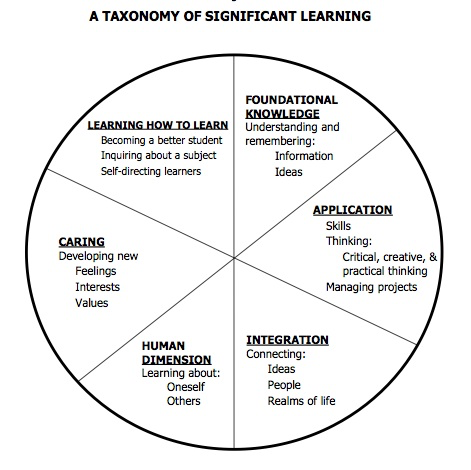Taxonomies
Taxonomies are useful tools that help educators create objectives, scaffold material and ensure that students are reaching higher order thinking. Each part of the taxonomy features verbs that designate different cognitive processes (e.g. recalling, critiquing). As you move from the bottom to the top, the cognitive processes become more difficult and require students to engage in higher level tasks. As you plan your courses and activities, consider creating objectives and questions that utilize different cognitive processes from each level of the taxonomy. There are two widely used taxonomies: Benjamin Bloom’s Taxonomy (1956) and L. Dee Fink’s (2013) Taxonomy of Significant Learning.
Bloom’s Taxonomy (1956):
| Knowledge | Recall specific ideas and information |
| Comprehension | Summarize ideas or information (without synthesizing other ideas) |
| Application | Take concepts or procedures and apply them to different situations |
| Analysis | Moves past summarizing information by breaking down the components of information and relating those components to other pieces of information |
| Synthesis | Putting ideas or concepts together to form something new |
| Evaluation | Being able to judge and access either material or application |
The revised version of Bloom’s Taxonomy (Anderson, et. al., 2001) describes and ranks six cognitive processes :
| Remember | Recognizing, recalling |
| Understand | Interpreting, exemplifying, classifying, summarizing, inferring, comparing, explaining |
| Apply | Executing, implementing |
| Analyze | Differentiating, organizing, attributing |
| Evaluate | Checking, critiquing |
| Create | Generating, planning producing |
Fink’s Taxonomy of Significant Learning embellishes Bloom’s Taxonomy by gesturing toward other learning objectives that are not accounted for like learning about oneself or caring. His taxonomy provides more food for thought when it comes to your instructional planning. Consider the wider scope of learning that can occur when you centralize the cognitive process of, for example, “developing new values.”

Image from: https://www.deefinkandassociates.com/GuidetoCourseDesignAug05.pdf
References:
Anderson, L.W., Krathwohl, D.R. (2001). A Taxonomy for Learning, Teaching, and Assessing: A Revision of Bloom’s Taxonomy of Educational Objectives. New York, New York: Longman.
Bloom, B. (1956). Taxonomy of Educational Objectives: Handbook One. New York, New York: Longman.
Fink, L.D. (2013). Creating Significant Learning Experiences: An Integrated Approach to Designing College Courses. San Francisco, CA: Jossey-Bass.
Marzono, R.J., Kendall, J.S. (2007). The New Taxonomy of Educational Objectives. Thousand Oaks, CA: Corwin Press.